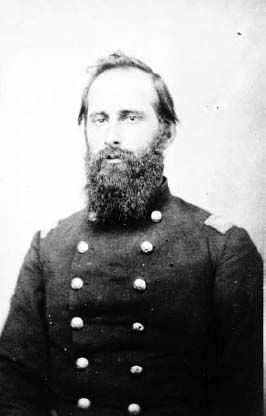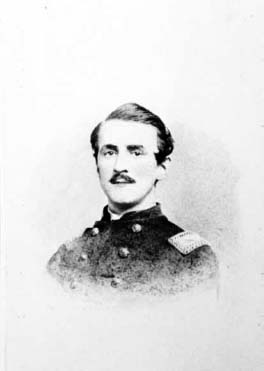The Battle of White Sulphur Springs (4 page)
Read The Battle of White Sulphur Springs Online
Authors: Eric J. Wittenberg

“We are to be made into a Cavalry Regiment and will have our horses in a few days,” noted a soldier of the 8
th
West Virginia, “but as it will take some time to drill and break the horses in we will fall back to the [Baltimore & Ohio] rail road or somewhere near to prepare for active service. And when we are sufficiently drilled I have no doubt we will have active service to do. I believe it is the intention to make Cavalry of all the [West] Virginia troops as soon as horses can be had.”
41
The 3
rd
and 8
th
West Virginia were converted from infantry to mounted infantry “inâ¦forty-eight hours by mounting the men on green horses.”
42
Unfortunately, the new horse soldiers were stuck with poor mounts. “Horses were not shod, and horses cannot travel over the rugged roads of this country without shoes, without breaking down very soon,” as Averell correctly observed.
43
However, given the strategic circumstancesâa large-scale Confederate invasion of Pennsylvania that was already underwayâthese nags would have to do, and the newly mounted infantrymen would have to make do with a minimum of training.

Colonel George R. Latham, commander of the 2
nd
West Virginia Mounted Infantry.
Ronnie Tront
.
Colonel George R. Latham commanded the 2
nd
West Virginia Mounted Infantry (later redesignated as the 5
th
West Virginia Cavalry). Latham was born near Haymarket, Virginia, on March 9, 1832. He attended local public schools as a child and then studied law. He was admitted to the Virginia bar in 1859, opening a practice in Grafton. Latham served as a delegate for the formation of West Virginia to the Wheeling Convention of 1861. A staunch Unionist, and in defiance of active Confederate recruitment then going on in Grafton, Latham nailed an American flag over his door and began enlisting troops for the Federal cause. By May 15, 1861, Latham had enrolled a full company and was using the streets of Grafton as a drill ground. On May 21, he was called to Wheeling to arrange to have his “Grafton Guards” mustered into service and was commissioned captain of Company B, 2
nd
West Virginia Infantry. He then was promoted to colonel of the regiment on May 24, 1862.
44
The 2
nd
West Virginia was the first West Virginia regiment enlisted for three years' service and was also the first mustered in under Governor Francis Pierpont. The regiment's ten companies consisted of men from Wheeling, Parkersburg, Grafton and the counties of Wetzel, Taylor and Ritchie. Men from the Ohio cities of Ironton and Bridgeport and the Ohio counties of Monroe and Belmont, as well as Pennsylvanians from Pittsburgh, Greenfield and Washington County, also filled the unit's ranks. They spent the first year of the war guarding the Baltimore & Ohio Railroad at Clover's Gap. In 1862, they campaigned against Stonewall Jackson in the Shenandoah Valley under Major General John C. Frémont and then became part of Major General John Pope's Army of Virginia. The regiment saw action at Kelly's Ford in early 1863 and then returned to West Virginia. The 2
nd
West Virginia suffered a defeat at Beverly on April 23, 1863, and remained there until Averell took command of the brigade. The unit was known to be “brave to the point of recklessness sometimes. It was said of [them] that whenever they got in a close place, every man was a general, and that they were almost invincible,” as the regimental historian recalled. “They certainly achieved some victories that seemed in the beginning hopeless.”
45

Lieutenant Colonel Francis Thompson, commander of the 3
rd
West Virginia Mounted Infantry.
Ronnie Tront
.
Lieutenant Colonel Francis Thompson commanded the 3
rd
West Virginia Infantry (which was later redesignated as the 6
th
West Virginia Cavalry). Thompson, age thirty-five, hailed from Morgantown. In 1850, when he was twenty-two, he migrated across the continent to California and then on to Oregon. In 1855, he served as captain of Company A of the 1
st
Battalion of Oregon Mounted Volunteers in the Yakima Indian War, and from 1856 to 1857, he served in a battalion of Oregon and Washington mounted rangers against Indians, learning several Indian dialects along the way. He returned to Morgantown, where he worked as a potter, miller and justice of the peace.
46
On May 28, 1860, Thompson was commissioned a first lieutenant in the 76
th
Virginia Militia. Governor John Letcher of Virginia commissioned Thompson a colonel and gave him authority to raise a regiment for the Southern service, but he refused the commission. Instead, he raised the first company for Union service in his county and was commissioned captain of Company A of the 3
rd
West Virginia Infantry in the summer of 1861. A few weeks later, he was promoted to lieutenant colonel. He was badly wounded at Second Bull Run but refused to leave the field until he toppled from his horse from loss of blood. He returned to duty in the spring of 1863.
47
His regiment was organized in the vicinity of Clarksburg on July 1, 1861. The 3
rd
West Virginia was the second regiment raised under the call for troops to serve the Union and consisted of ten companies of men from the West Virginia counties of Monongalia, Harrison, Preston, Upshur, Taylor, Marshall and Ritchie and from the border area of southern Pennsylvania. It spent the first months of its service doing outpost duty in West Virginia and then joined Brigadier General Robert H. Milroy's command in the Shenandoah Valley in April 1862. It also fought against Jackson in the valley under Frémont's command and then fought at Second Bull Run. It performed outpost duty in West Virginia in September 1862 and remained there until Averell assumed command of the Fourth Separate Brigade in May 1863.
48

Colonel John H. Oley, commander of the 8
th
West Virginia Mounted Infantry.
Steve Cunningham
.
Colonel John Hunt Oley commanded the 8
th
West Virginia Infantry (later redesignated as the 7
th
West Virginia Cavalry). Oley was born in Utica, New York, on September 24, 1830. Remembered as “a man of tremendous driving force,” Oley was a merchant and telegraph operator before the war. In April 1861, he enlisted in Company H of the 7
th
Regiment of New York National Guard, a unit “in which every man was a trained soldier and fit to command.” That summer, Governor Pierpont asked that six men of the 7
th
Regiment be sent to train West Virginia soldiers, and Oley was one of the men chosen. He organized the 8
th
West Virginia Infantry and was commissioned major in October 1861. He was promoted to lieutenant colonel on August 24, 1862, and to colonel on March 1, 1863. A friend remembered him as “a fine-appearing officerâintelligent, a good disciplinarian, and in every respect thoroughly qualified to command.” The same friend also claimed that Oley “endeared himself to the officers and men of his regiment and had the respect and confidence of his superior officers.”
49
His regiment, the 8
th
West Virginia, was organized in Charleston in the fall of 1861. The regiment's ten companies consisted of men from the surrounding area. It served in the Shenandoah Valley against Jackson under Frémont and fought at Harrisonburg and Cross Keys. It also served in Pope's Army of Virginia as part of Major General Franz Sigel's corps. In November 1862, the regiment was first transferred to Colonel Augustus Moor's brigade and then was assigned to Averell's Fourth Separate Brigade in May 1863.
50

Colonel James M. Schoonmaker, commander of the 14
th
Pennsylvania Cavalry.
Ronnie Tront
.
Colonel James M. Schoonmaker commanded the 14
th
Pennsylvania Cavalry. Schoonmaker was born in Allegheny (now part of Pittsburgh), Pennsylvania, on June 30, 1842, the son of a wealthy drug and paint wholesaler. He was nineteen and was enrolled at Western University of Pennsylvania (now known as the University of Pittsburgh) when the war began. Already an accomplished horseman, he enlisted as a private in a local company that was mustered into the 1
st
Maryland Cavalry (U.S.). Within just a few weeks, he was promoted to second lieutenant and served in the August 9, 1862 Battle of Cedar Mountain. The young soldier had a difficult time adjusting to army life, as his colonel was a martinet.
51
However, as one biographer noted, “In all these positions he had shown the soldiership which led to his advancement.”
52
He was a gifted guitar player and singer and often played for his men to prevent them from becoming homesick.
53
That summer, he was sent to Pittsburgh to recruit a new cavalry battalion of five companies and filled the ranks of that battalion so quickly that he instead received authority to recruit a full regiment of twelve companies, to be called the 14
th
Pennsylvania Cavalry. In November 1862, at the precocious age of just twenty, Schoonmaker was commissioned colonel of the 14
th
Pennsylvania, making him the youngest colonel in the Union
army
. Secretary of War Edwin M. Stanton objected to the commission of such a young man as a colonel, but he nevertheless sent Schoonmaker on to Pennsylvania governor Andrew G. Curtin, who issued the commission.
54
Those twelve companies were composed mainly of men from Allegheny, Fayette, Armstrong, Washington, Lawrence, Erie and Warren Counties and also included a detachment of men from Philadelphia. The new regiment mustered and trained in the Pittsburgh area and was then sent to Hagerstown, Maryland, where it received its full complement of horses and weapons. The men were trained in the various drills and evolutions of the line until they were garrisoned at Harpers Ferry in December 1862 as part of Brigadier General Benjamin F. Kelley's command. In May 1863, they were sent to Grafton, where they joined the Fourth Separate Brigade.
55